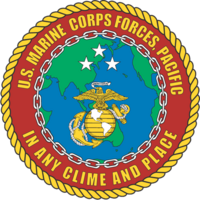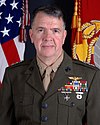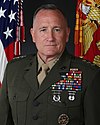Service component command of U.S. Marine Corps
Military unit
The U.S. Marine Corps Forces, Pacific (MARFORPAC) is the Marine Corps service component command of U.S. Indo-Pacific Command. It is the largest field command in the Marine Corps and is headquartered at Camp H. M. Smith in Hawaii. The MARFORPAC area of responsibility covers more than half of the Earth's surface.
It is composed of the I Marine Expeditionary Force (I MEF) and the III Marine Expeditionary Force (III MEF). Each MEF comprises a command element (CE), a ground combat element (GCE) (1st and 3rd Marine Divisions), an aviation combat element (ACE) (1st and 3rd Marine Aircraft Wings), and a logistics combat element (LCE) (1st and 3rd Marine Logistics Groups).
History
Although the U.S. Marine Corps has had units stationed in the Pacific region since World War II, Marine Corps Forces Pacific (MARFORPAC) was not established as a service component of Pacific Command until 31 July 1992.[1] The Commander, Marine Forces Pacific, is dual-hatted as Commanding General, Fleet Marine Force Pacific, a position that existed since 1944. General Holland Smith, the first commander of Fleet Marine Force Pacific, established its headquarters in the summer of 1944 to lead over 500,000 Marines in the theater that were subordinated to the U.S. Pacific Fleet.[2]
After its creation in 1992, MARFORPAC was initially one of only two Marine service component commands, along with Marine Corps Forces Atlantic. During the 1990s MARFORPAC commanded two-thirds of the combat units in the Marine Corps, totaling to over 80,000 Marines, and was responsible for providing forces to not only Pacific Command, but also to Central Command and the United States Forces Korea. Accordingly, the Commander of MARFORPAC was also the Commander of Marine Corps Forces Central Command (MARCENT) from the 1990s until it became a completely separate headquarters in 2005. In 2002, then-commander of Marine Forces Pacific, Earl B. Hailston, temporarily moved from Hawaii to the Arab states of the Persian Gulf to oversee operations in the Middle East. The expansion of MARCENT during the War on Terror led to it being made a free standing headquarters under Central Command. Even after the removal of MARCENT from its area of responsibility, MARFORPAC remains the largest field command in the Marine Corps.[2][3] A subordinate command for Marines in South Korea (Marine Corps Forces Korea or MARFORK) was also created in 1995, answering to MARFORPAC and U.S. Forces Korea.[4]
Mission
As the assigned service component to United States Indo-Pacific Command area of responsibility, Marine Forces Pacific is responsible for the support, planning, and provision of forces in the INDOPACOM AOR or elsewhere as required and may be designated as an executive agent for standing responsibilities or named operations. Longstanding missions for MARFORPAC include building partner capacity in support of regional cooperation and capacity-building efforts, as well as the defense of South Korea (via subordinate command MARFORK) and Japan.[5] Marine Forces Pacific also provided combat units to support Operation Iraqi Freedom and Operation Enduring Freedom.[3]
Organization
Marine Corps Forces Pacific consists of I Marine Expeditionary Force (I MEF) and III Marine Expeditionary Force (III MEF). According to the Commandant's Planning Guidance from 2019, I MEF will be designed to provide support to the U.S. Third Fleet while III MEF will provide support to the U.S. Seventh Fleet.[6] U.S. Marines in South Korea have their own subordinate command, Marine Corps Forces Korea, that also answers to MARFORPAC, though it has no combat units assigned to it.[4]


















